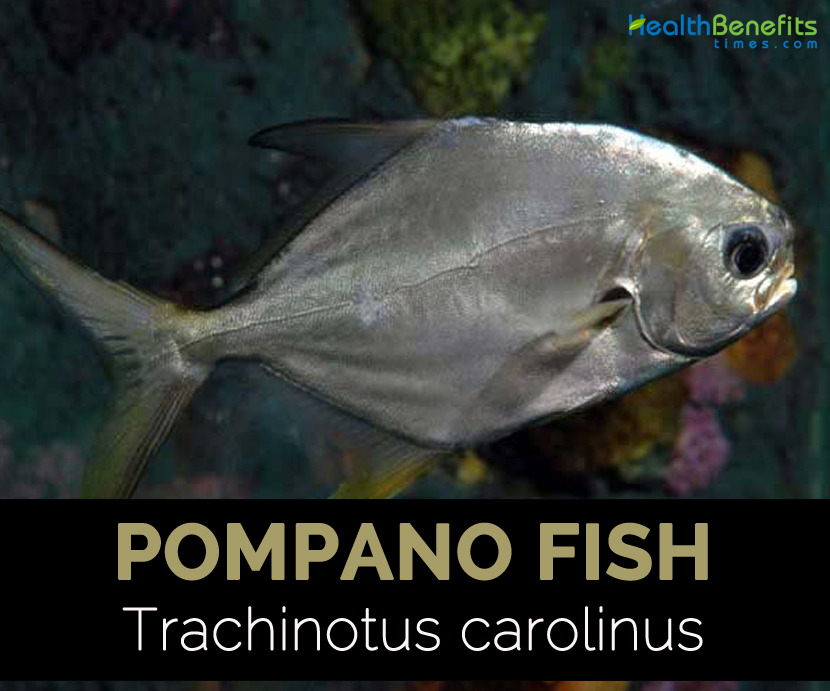| Pompano Fish Quick Facts | |
|---|---|
| Name: | Pompano Fish |
| Scientific Name: | Trachinotus carolinus |
| Colors | Blue-greenish silver |
| Shapes | Short, deep, compressed, 17-25 inches in length |
| Flesh colors | White to off-white |
| Taste | Mild, succulent |
| Calories | 186 Kcal./cup |
| Major nutrients | Selenium (74.91%) Isoleucine (57.48%) Lysine (57.24%) Tryptophan (52.95%) Threonine (51.88%) |
It lives in the warm waters of the south Atlantic from Cape Cod to Brazil. They should not be confused with the California pompano which is in fact a member of the butterfish family and not a pompano at all. It is a fast growing fish, reaching 8-12 inches in its first year. They usually live about 3 to 4 years. It is blue-greenish silver dorsally and silver to yellow on body and fins. It averages 1 ½ to 3 pounds however they have been to reach 9 pounds and 26 inches in length. They are a fairly expensive fish because of high demand and commercial fishing restrictions.
There are several fish species in the genera Trachinotus that are marketed as pompano. The name pompano has long been used broadly to refer to many different species within this large family of fish called jacks (Carangidae). Pompano became popular in the United States primarily because of the domestic sport and commercial fishery along the coast of Florida for Trachinotus carolinus. This species is the most expensive and preferred due to its wonderful flavor, texture and fat content. This species of pompano is highly valued as a food fish both commercially and recreationally. They are characterized by their greenish gray and silver color.
Habitat
Florida pompano are common in inshore and near shore waters, especially along sandy beaches, along oyster banks, and over grass beds. They are often in turbid water and may be found in water as deep as 130 feet.
Physical Appearance
The body profile is compressed with short snout. Color is normally blue-greenish silver on the dorsally and is silver to yellow on body and fins. There are no visible vertical bars on sides. Fins are dusky or yellowish in color, mainly the anal fin. The tail fin is deeply forked. The head profile slopes to a blunt snout, with the mouth somewhat inferior. The adult Florida Pompano can range from 17 – 25 inches in length. The angler caught Florida Pompano is usually 3 lbs or less. Florida Pompano rarely grow more than 6 Lbs.
Six short spines are located in front of an elongated dorsal fin, which is set low on the fish’s back and is matched by a slightly shorter anal fin underneath. The first few soft rays (spines) of these fins are elongated, followed by a narrow band of soft rays that lead to the deeply forked V shaped tail. The dorsal fin has 22 to 27 soft rays (spines); the anal fin has 20 to 23 rays (spines). The fins of pompano may be yellow.
Types
Different types of pompano fish are described below
1. African pompano
2. Irish pompano
Health Benefits of Pompano fish
Discussed below are the health benefits offered by pompano fish:
- Enhance metabolism
The high content of Vitamin B assists in bodily functions such as to increase the body’s metabolism. The fish belonging to this genus has adequate amounts of riboflavin, niacin, thiamine and pyridoxine.
- Lowers bad cholesterol
Pompano fish has saturated fat in it and is the great source of polyunsaturated fat and monounsaturated fats. It contains high concentration of unsaturated fat which is essential to fight HDL.
- Strong bones
Moreover, pompano fish is useful in strengthening bone. This fish has various compounds that prevent weakness and fragility of bones.
- Brain health
This fish has healthy fats that assist in improving cognitive function and lower the chances of neurogenerative diseases.
- Require for growth
A fillet of pompano fish provides 40% of regular protein. Moreover, it is a perfect source of amino acids essential for development and growth of the body.
Nutritional Value
Apart from their mild, succulent-taste, Pompano fish is a good source of nutrients, vitamins and minerals. Consuming 88 gram of Pompano fish offers 41.2 µg of Selenium, 0.598 mg of Vitamin B1, 1.06 µg of Vitamin B-12, 300 mg of Phosphorus, 20.85 g of Protein, 10.68 g of Total Fat, 3.344 mg of Vitamin B3, 0.202 mg of Vitamin B6 and 0.766 mg of Vitamin B5. Moreover many Amino acids 0.233 g of Tryptophan, 0.913 g of Threonine, 0.961 g of Isoleucine, 1.694 g of Leucine, 1.914 g of Lysine and 0.617 g of Methionine are also found in 88 gram of Pompano fish.
How to Eat
- Pompano is typically prepared baked, broiled, grilled or pan-fried.
- A popular dish created in New Orleans, called “pompano en papillote,” is wrapped in parchment paper with a white sauce of wine, shrimp, and crab meat, and then steamed.
- To enjoy the pure flavor of the fish, try it on the grill or baked with a little oil or butter, salt and pepper.
- Cut the cleaned fish into slices, dredge with flour, and fry brown in butter. Serve with any preferred sauce.
- Pompano, because of its high fat content, works well with complex sauces.
Precautions
- Pompano fish contains mercury.
- Limit its intake to reap health benefits.
- Some people might experience allergic reactions. Seek for medical attention and avoid its intake.
Other Facts
- Pompano do not have teeth.
- Largest pompano fish weigh 8–9 lb. (3.6–4.1 kg) and reach lengths up to 26 in (66 cm).
References:
http://www.clovegarden.com/ingred/sf_pompcz.html
http://www.cport.net/product/view/pompano
https://en.wikipedia.org/wiki/Pompano
https://en.wikipedia.org/wiki/Florida_pompano
http://www.fishingdestinguide.com/FISH-POMPANO.html
http://seafood.edf.org/pompano
http://www.seafoodsource.com/seafoodhandbook/finfish/pompano
https://www.organicfacts.net/pompano-fish.html
https://www.thealthbenefitsof.com/pompano-fish/
Comments
comments
